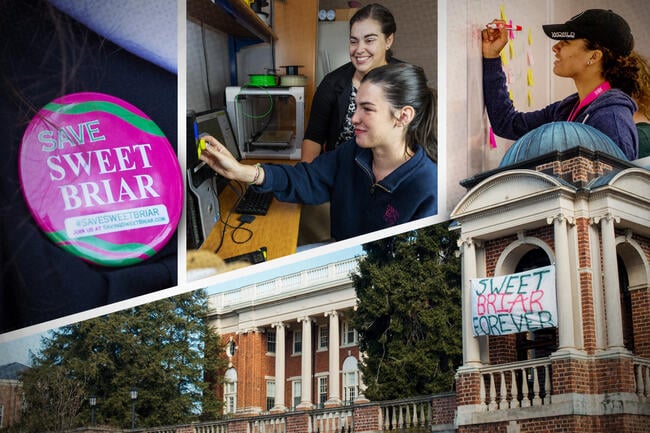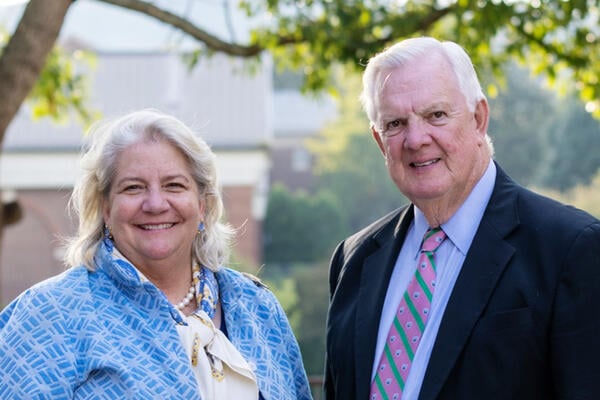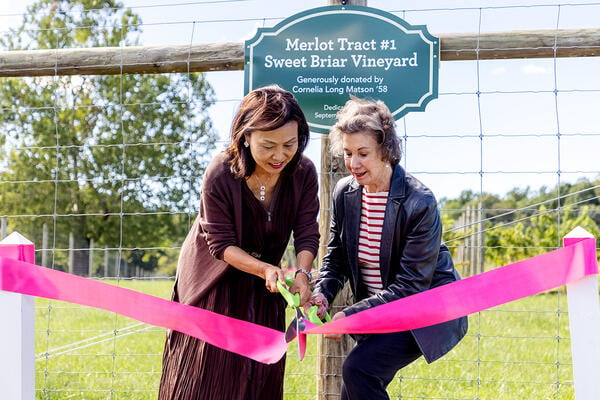You have /5 articles left.
Sign up for a free account or log in.

Sweet Briar College alumnae defied the odds by fighting a closure attempt and winning.
Photo illustration by Justin Morrison/Course Strat | Jabin Botsford/The Washington Post/Getty Images | Sweet Briar College
Ten years ago this month, the leaders of Sweet Briar College announced the institution would close due to “insurmountable financial challenges.” Enrollment at the all-women college was falling while the tuition discount rate continued to climb, creating an unsustainable fiscal situation, the closure announcement said. Officials involved in the decision noted the declining popularity of single-sex education and the challenges of drawing students to rural Virginia.
“We are 30 minutes from a Starbucks,” then-president James F. Jones Jr. said.
Shutting down was the responsible thing to do, officials argued, and would allow students to transfer out and avoid the likelihood of an otherwise abrupt closure.
“We voted to act now to cease academic operations responsibly, allowing us to place students at other academic institutions, to assist faculty and staff with the transition and to conduct a more orderly winding down of academic operations,” then–board chair Paul G. Rice said in 2015.
The move sent shock waves through the community. Questions and rumors swirled over what would become of Sweet Briar’s endowment and its expansive, bucolic campus dotted with horses and framed by the Blue Ridge Mountains.
Ten years on, horses still graze on the hills and the stately brick buildings echo with the sounds of students at work and play. Thanks to a hard-fought legal battle and the leadership and generosity of hundreds of devoted alumnae, Sweet Briar College remains open.
Gearing Up for a Fight
Mary Pope Maybank Hutson became Sweet Briar’s president in 2023, after serving in alumnae relations and development for eight years. But back in 2015, she was the executive director of the conservation nonprofit the Land Trust Alliance, preparing for a speech in Sacramento when she got word that her alma mater would close. She was shocked by the news.
“It was emotional,” Hutson told Course Strat. “I felt as if I’d had a death in the family, a loss that I would have never imagined because of my amazing experiences at Sweet Briar, and my connection to it, my connection to my classmates and the institution, and the faculty and staff who I knew at the institution over those four years that were foundational to my life.”
She was also skeptical that the college was in such dire shape.
“The reasons that they used to close the college were, I think, manufactured to a national audience. That we couldn’t raise money, that we were too far in the country, 30 minutes from a Starbucks, and no one wanted to go to a women’s college. Keep in mind that Sweet Briar was a 114-year-old institution at that point. We’ve had a long history of overcoming many odds,” Hutson said.
Like many other Sweet Briar graduates, she was unwilling to accept the decision. Stuck in the Phoenix airport on her travels, Hutson joined a hastily arranged conference call with more than 250 alumnae across the country who united to fight back against plans to close the college. They assembled separate teams to focus on communications, fundraising and the looming legal battle.
The Saving Sweet Briar 501(c)(3) emerged as a coordinated effort to fight back. But it was the Amherst County Attorney’s office that led the legal challenge, filing a lawsuit in March 2015 to block the closure attempt. Shortly after, the attorneys filed a motion for a temporary injunction against Sweet Briar’s Board of Directors, seeking to prevent them from shutting down the college and to replace the board with a “special fiduciary” appointed by the court to operate the college and oversee its assets.
Then–Amherst County Attorney Ellen Bowyer argued that college officials had no authority to shut down Sweet Briar because it had been established via a charitable gift in the 1901 will of Indiana Fletcher Williams. Her will stipulated that assets, including more than 3,000 acres of land, be used to establish a women’s college to honor the memory of her late daughter, Daisy Williams.
Initially, a judge denied the injunction in part, finding that the court did not have the authority to stop the closure. But Virginia’s Supreme Court disagreed; on June 9, 2015, it sent the case back to the same circuit court judge. Within weeks, Sweet Briar’s administration folded, agreeing to a settlement to relinquish control to new leadership. Alumnae were elated by the victory.
As part of the settlement, the Board of Visitors was reconstituted to allow Saving Sweet Briar to appoint new members. The remaining members of the board all stepped down.
But the legal victory did not guarantee that the college would stay open. Sweet Briar’s finances remained a key concern, prompting a fundraising flurry as supporters contributed $12 million between March and June to keep the college open. The Virginia attorney general also lifted restrictions on $16 million in operating funds, enabling Sweet Briar to set a $28 million budget.
Rebuilding the College
After the ruling to keep the college open, Sweet Briar needed new leadership. Enter Phil Stone.
Stone served as president of Bridgewater College, a small private arts college roughly 80 miles north of Sweet Briar, from 1994 through 2010, before retiring to run a law firm with his children.

Mary Pope Maybank Hutson and Phil Stone were crucial fundraisers in the fight to save SBC.
Sweet Briar College
Like Hutson, he was shocked by the news of the attempted closure, given that Sweet Briar had recently been reaccredited, had a decent endowment and did not appear financially distressed.
“I thought of all the schools that might be in jeopardy and about to close, and I knew of some—not Sweet Briar. They had never been on anybody’s radar for that. It was shocking,” Stone said.
He was recruited to serve as the “special fiduciary.” Given his belief that Sweet Briar could be saved, he agreed to take on the role even before the legal victory. And when the closure effort was rebuffed, Stone suddenly found himself a college president again.
“I was walking my dog at home in Harrisonburg when I got a call from one of the lead attorneys handling the Sweet Briar effort, and he said, ‘Phil, we’ve reached an agreement. In about two weeks, you’ll be president.’ And I said, ‘Oh, my Lord, I have to go and tell my wife,’” Stone said.
When he retired from Bridgewater, Stone looked forward to having nights and weekends to himself. That abruptly changed when he took the Sweet Briar job—especially in the early days. To get the shuttered college up and running again, he had to convince students and employees to return, woo donors, negotiate with creditors (and accreditors), and rehire vendors to provide essential services on campus.
“I had no faculty, no students, nothing. I didn’t even know where the president’s office was,” Stone said.
Stone also did not have access to campus until a court mandated that the outgoing administration hand over the facilities on June 30. Even then, former president Jones remained in the SBC president’s house for a while, prompting Stone to briefly move into the Elston Inn & Conference Center on campus. In his first act as president, Stone had Sweet Briar’s information technology staff post a statement to the website telling employees they would be rehired, even though he had no idea how many employees that entailed or how many had taken jobs elsewhere. He also dismissed senior administrators who had stayed on to shut the campus down because he felt they had lost the trust of the Sweet Briar community.
Amid the hiring and rehiring spree, Stone tapped Hutson as chief fundraiser.
Stone also clawed back resources, including the college’s 56 horses that had been destined for another institution, negotiated handshake deals with vendors to provide food and other services, and began a media and fundraising blitz that took him across the country.
On Aug. 27, 2015, Sweet Briar began its fall semester, almost six months after the closure announcement. While the college had enrolled nearly 700 students the prior fall, many did not return. Sweet Briar reopened with 315 students in its comeback semester.
Stone admits the semester wasn’t perfect—but the campus community accepted that with grace.
“I think there were people ready to make the compromises that we needed to make if we didn’t have a faculty member teaching something, or couldn’t buy certain things, or couldn’t polish certain things,” Stone said. “They understood that we were fighting for our lives.”
‘Get Money, Get Students’
After two years in the job, Stone retired again. While he had helped to stabilize the college, he believed it was up to someone else to craft its vision going forward.
The board then hired Meredith Woo as president in 2017.
Though the college had survived the closure attempt, its finances were still shaky. As president, Woo drove an academic restructuring that slashed majors from 42 to 16, cutting some staff and faculty jobs. She also overhauled the core curriculum to emphasize women’s leadership, reset tuition—dropping the sticker price from $36,000 to $21,000—and boosted enrollment, which had fallen to about 200 students by the time she took office but grew to 462 by the time she left in mid-2023.
Woo also invested in a number of initiatives, renovating Sweet Briar’s equestrian center and leaning into the college’s agricultural history and vast acreage by adding a 26,000-square-foot greenhouse and an 18-acre vineyard. Sweet Briar wines recently won three awards in a Virginia competition, and its farm now sells produce to the local community and restaurants.
To Woo, it seemed like the prior board and leadership had lost faith in Sweet Briar’s mission and viewed it as something of an anachronism.
“The job for us was to take the same immutable facts—that it’s a liberal arts college, it’s a women’s college, and that it is located in rural Virginia—and turn those into the most exciting ideas,” Woo said. “To make liberal arts sing with excitement and make women’s education relevant for the 21st century, and make rural Virginia into a location where the beautiful 3,000 acres of campus can be used as a laboratory for studying the liberal arts.”

Former SBC president Meredith Woo, left, was instrumental in setting a vision for Sweet Briar.
Sweet Briar College
After Woo stepped down, Hutson was tapped as interim president. In November 2023, after eight years of leading alumnae relations and development efforts, the interim tag was lifted.
Enrollment this fall stood at about 430 students, a number that Hutson is working to increase. She borrowed a mantra from Stone—“get money, get students”—in her approach to the presidency. While enrollment has not risen to what it was before the closure attempt, many other institutions have also seen head counts fall since 2015, a result of the COVID-19 pandemic and changing demographics, among other factors.
Despite donor generosity, Hutson noted SBC has little room for error, given its limited size and resources and the difficult headwinds battering higher education—particularly small liberal arts colleges. Hutson has stressed the importance of “eternal vigilance” in keeping Sweet Briar alive.
“Sweet Briar is not going to save itself—that’s what we all said [in 2015]. So every day we got up to move Sweet Briar forward into a more stable position, and we continue to work every single day to strengthen the college and put it in a place where it will be secure for the future,” she said.
Unlikely Success
Staving off closure via fundraising is a strategy that experts note is largely doomed to fail.
Recent efforts at the King’s College in New York City and Northland College in Wisconsin to raise money to stave off closure both failed, prompting both institutions to shut down in short order. The King’s College needed $2.6 million to stay alive, while Northland sought $12 million.
Doug White, a philanthropy adviser, said donors are often reluctant to take a risk.
“‘Survival fundraising’ is almost an oxymoron to me, because people want to give money to a cause that’s going to grow and not be on the brink of disaster in the future,” White said. “The mindset, the psychology of giving, is one of saying, ‘OK, I’m going to support something that’s not only important, but that’s going to be around for a while.’ And for that first year [at Sweet Briar], and into the second, there was a real question about whether it was going to continue.”
He added that he is not aware of another institution that parallels Sweet Briar in terms of fending off closure.
“A lot of these colleges don’t have the ability to do what Sweet Briar did. Who knew that Sweet Briar had that ability? But there was some special loyalty, some special experience that was common to all of these women, and they weren’t going to say goodbye,” White said.
Over 10 years, Sweet Briar alumnae have donated $160 million to the college.
They show no sign of slowing down. A Sweet Briar spokesperson noted that the college’s March Days of Giving event, now in its 10th year, raised nearly $2.6 million this month. That’s the second-highest total for the annual fundraising event, according to the college.
Now watching from the outside, Woo believes the secret to sustained success at Sweet Briar is to emphasize what she believes it does best: deliver high-quality, intensive and innovative instruction in small classroom settings.
“In this day and age, when technology opens all kinds of possibilities at Sweet Briar, we need to partake in that to use technology in the best way possible, but remain true to the real importance of human interactions,” Woo said.








